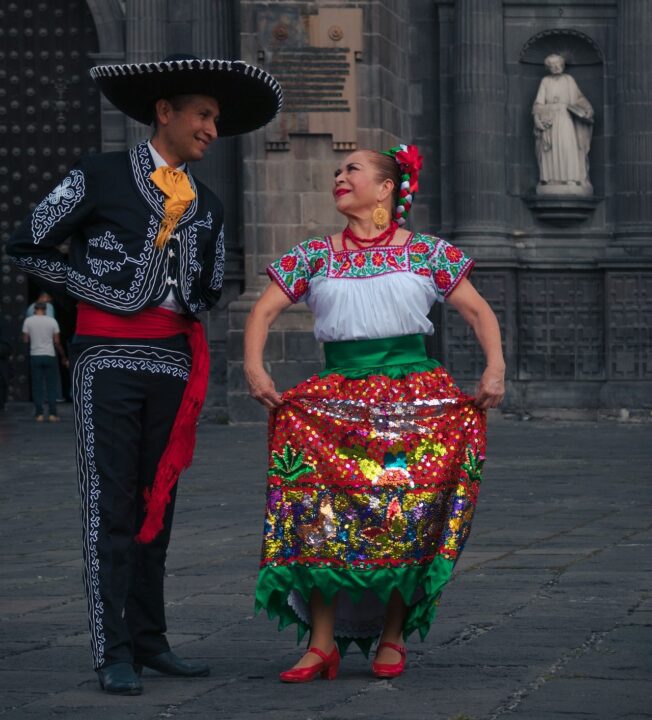Imagine yourself strolling down the streets of Mexico, surrounded by the mesmerizing sights and sounds of mariachi music, the aroma of delicious street food wafting through the air, and the vibrant colors of traditional dresses adorning the locals. Mexican traditional dress is a kaleidoscope of creativity, a feast for the eyes that captures the essence of Mexico’s rich cultural heritage.
But what makes traditional Mexican dress so special? It’s the intricate embroidery that tells stories of ancient civilizations, and the bold use of colors mirrors the vivacious spirit of the Mexican people. It’s the unique styles and patterns that pay homage to the diverse indigenous cultures that have shaped the country’s identity. Mexican traditional dress is a living testament to the fusion of history, art, and a love for life.
Mexican traditional wear will make you the star of the party, whether you’re attending a raucous fiesta, touring a local market, or just adding a bit of Mexican flare to your wardrobe. From the elegant China Poblana dress to the dashing Charro suit, each garment tells its own story and invites you to become part of Mexico’s vibrant tapestry.
Mexican Traditional Dresses
Grab your maracas, practice your salsa moves, and let’s dive into the joyous world of Mexican traditional dress!
1. China Poblana: The Queen of Elegance
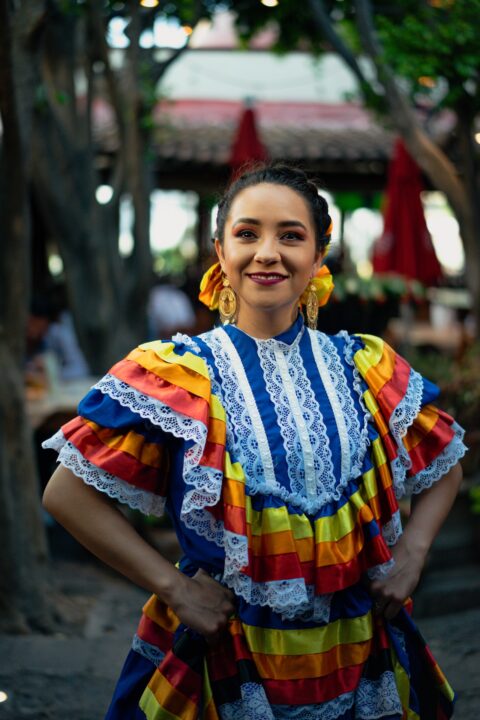
Dating back to the 17th century, the China Poblana dress holds historical significance as it represents the fusion of Chinese and indigenous Mexican cultures. Legend has it that a young Chinese woman, Catarina de San Juan, arrived in Mexico and eventually became a symbol of Mexican identity.
The China Poblana dress features a beautifully embroidered blouse, a full skirt adorned with ruffles, and a rebozo (a shawl-like garment) gracefully draped over the shoulders. With its intricate embroidery depicting colorful flowers and intricate patterns, this dress showcases the craftsmanship and artistry of Mexican artisans. Wearing the China Poblana dress will transport you to the heart of Mexico’s rich history and leave you feeling like royalty.
2. Adelita: Channeling the Spirit of Revolution
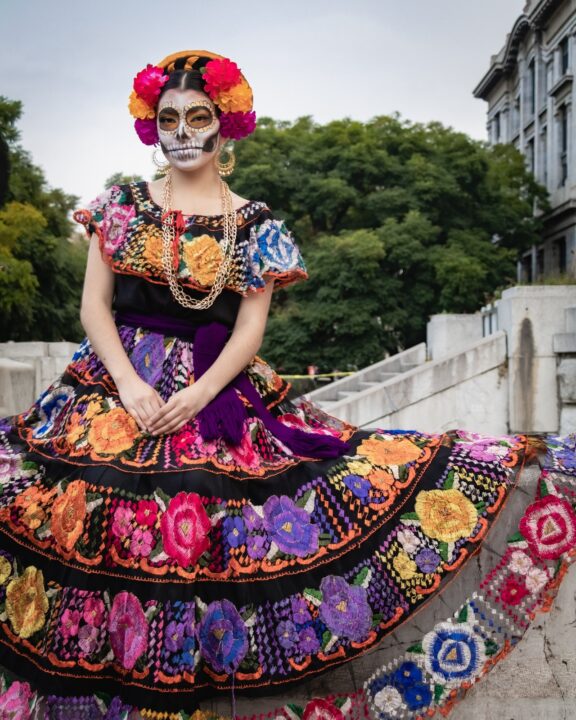
The Adelita dress pays homage to the courageous female soldiers, known as Adelitas, who fought during the Mexican Revolution (1910–1920). These fearless women played a significant role in the struggle for justice and equality. The Adelita dress features bold colors, intricate embroidery, and empowering details. Typically, it includes a long, flowing skirt with vibrant floral patterns and a matching blouse adorned with ruffles and lace.
3. Charro: Suave and Dashing
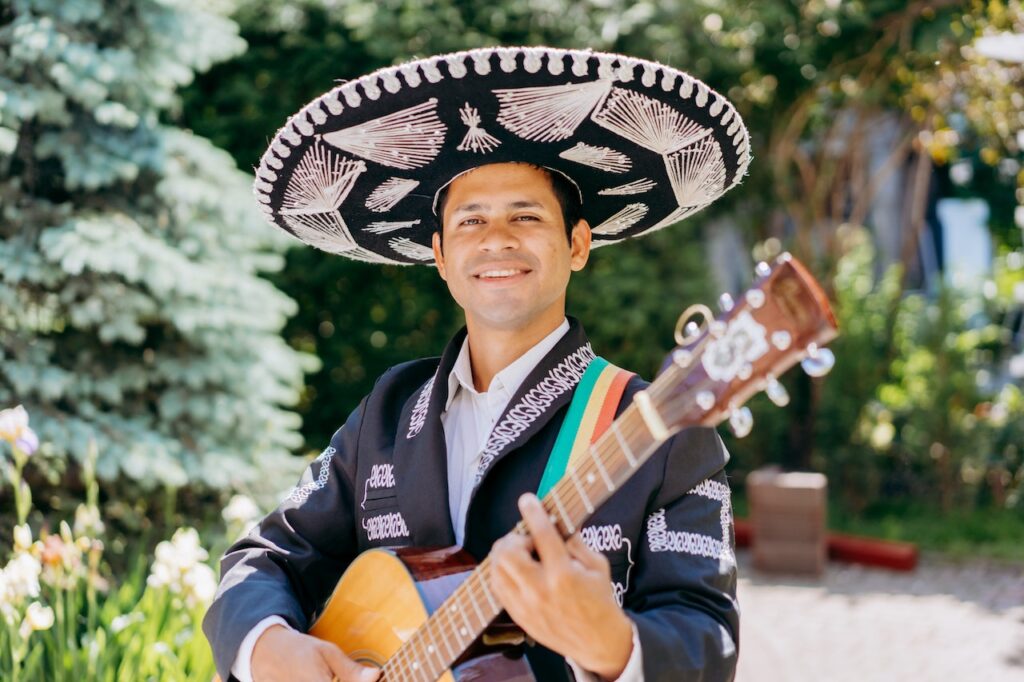
The Charro suit has its roots in the equestrian traditions of Mexican ranchers, known as charros. Dating back to the 18th century, Charro attire became a symbol of Mexican cowboy culture and elegance. The traditional Charro suit features an embroidered jacket, fitted pants, a wide-brimmed sombrero, and intricately decorated boots.
The Charro suit exudes masculinity, confidence, and a hint of cowboy charm. With its impeccable tailoring, exquisite embroidery, and attention to detail, this outfit is quite attractive.
4. Huipil: Embrace the Magic of Embroidery
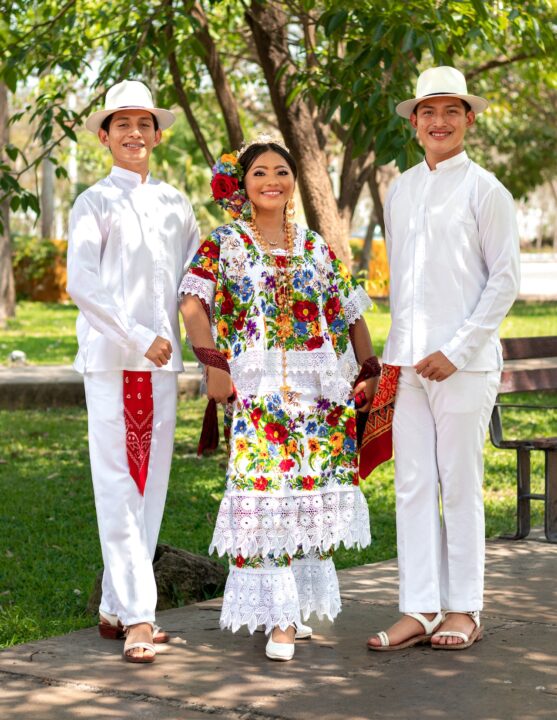
The Huipil is a traditional dress that can be traced back thousands of years to pre-Columbian times. Indigenous groups wear it throughout Mexico and Central America. This loose-fitting tunic is adorned with vibrant embroidery, showcasing ancient symbols and cultural motifs.
Each Huipil is a unique work of art, with intricate patterns and symbols that reflect the cultural identity of the region it comes from. From the lively patterns of the Huipiles from Oaxaca to the geometric designs of those from Chiapas, the Huipil showcases the diversity and artistry of Mexican embroidery. With its flowing silhouette and intricate details, the Huipil will make you feel like a walking work of art.
5. Oaxacan Tehuana: Bold, Beautiful, and Bold Again
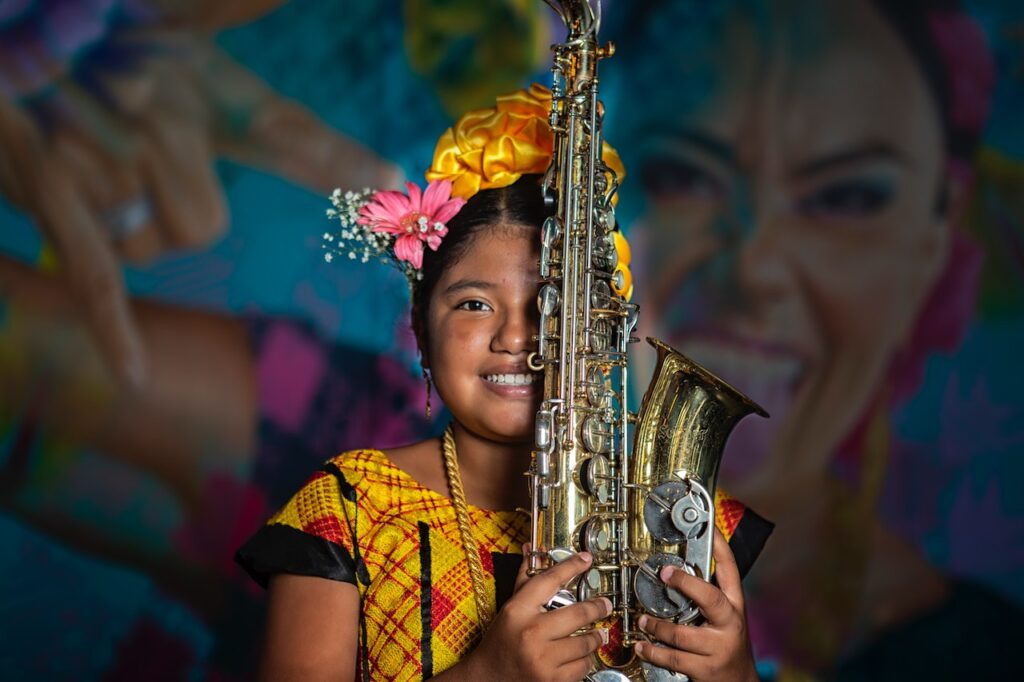
The Tehuana dress originates from the Zapotec indigenous culture of Oaxaca and is associated with the Tehuantepec region. It has a rich history and symbolizes the strength and beauty of Tehuantepec women. The Oaxacan Tehuana dress is characterized by its fitted, off-the-shoulder blouse with a voluminous skirt. It exudes confidence and femininity, reflecting the vibrant culture of Oaxaca. The Tehuana dress showcases vibrant colors, intricate embroidery, and the use of luxurious fabrics like velvet and silk. Its striking colors and intricate floral patterns celebrate the rich cultural heritage of Oaxaca and will make you the center of attention wherever you go.
6. Zacatecas Piteado: When Style Meets Craftsmanship
The Zacatecas Piteado dress combines traditional elements with intricate leatherwork. Piteado is a leather embroidery technique that originated in Spain and was brought to Mexico during the colonial era. This unique dress showcases vibrant colors, bold patterns, and intricate leather embroidery. The Zacatecas Piteado dress represents the fusion of style and craftsmanship. Each piece tells a story and represents the dedication of artisans in Zacatecas.
7. Yucatecan Huipil: A Tapestry of Tradition
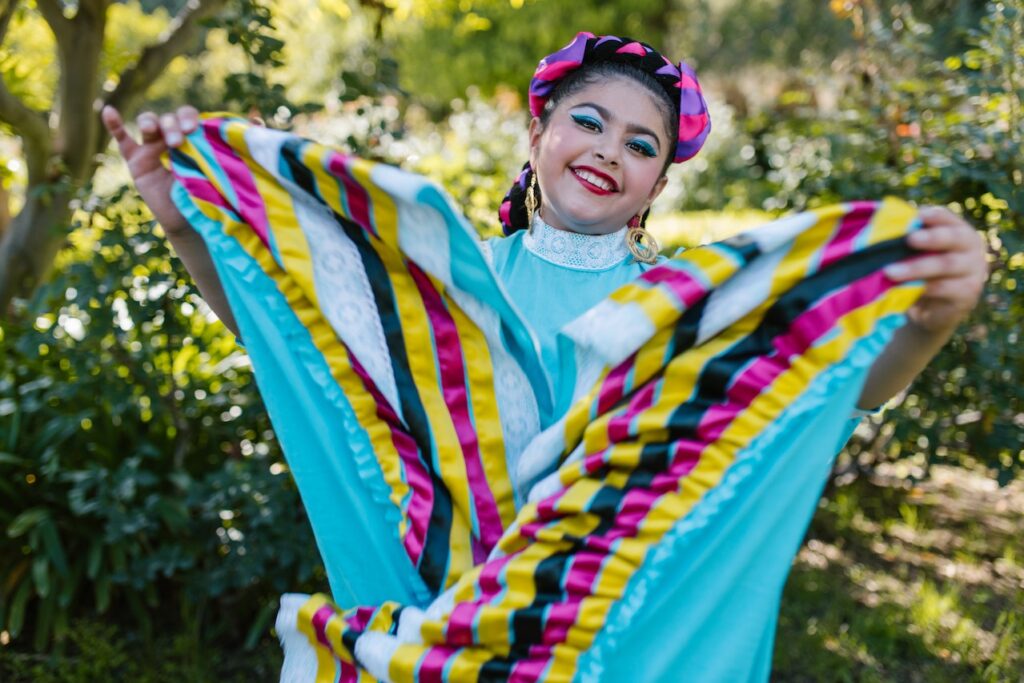
The Yucatecan Huipil dress reflects the Mayan heritage of the Yucatan Peninsula. It showcases delicate lacework, colorful floral embroidery, and a flowing silhouette that captures the essence of tropical elegance. The Yucatecan Huipil dress is characterized by its intricate brocade patterns and its use of lightweight, breathable fabrics, perfect for the warm climate. This dress transports you to a world of warmth and beauty, celebrating the cultural traditions of the Yucatan Peninsula.
8. Jalisco Dress: Ruffles and Romance
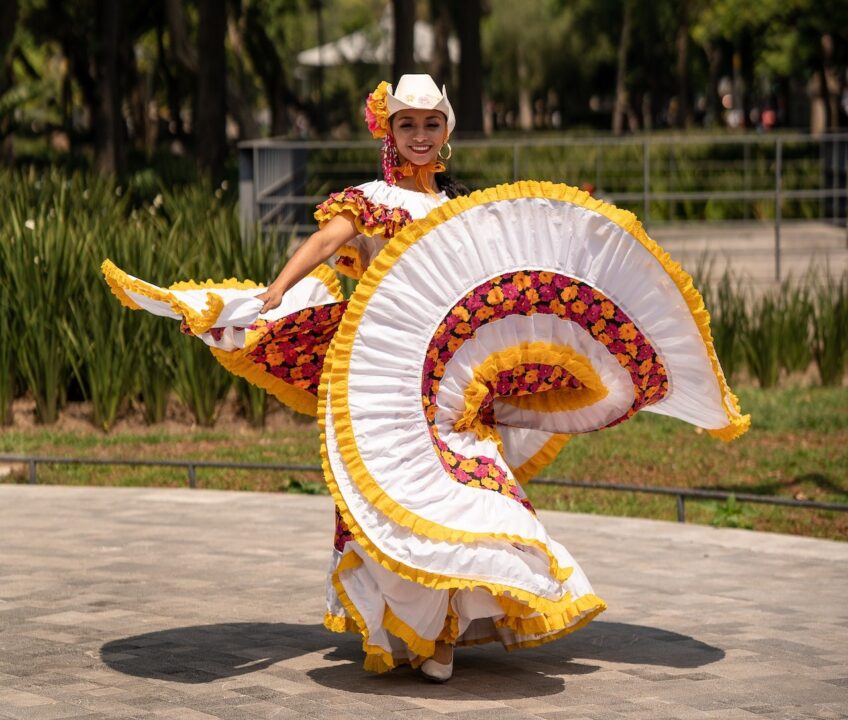
The Jalisco dress, also known as the “China Jalisciense,” draws inspiration from the China Poblana and the Adelita dresses. It is closely associated with the vibrant culture of Jalisco, known for its mariachi music and traditional dances. The Jalisco dress features layers upon layers of ruffles, creating a mesmerizing silhouette that’s perfect for twirling on the dance floor. With its lively colors, bold embroidery, and intricate details, it captures the essence of Jalisco’s vibrant culture and festive spirit. Put on the Jalisco dress, let the ruffles flutter with your every move, and embrace the romanticism and energy that define this beloved Mexican dress.
9. Veracruz Son Jarocho: Music, Dance, and Style
The traditional music and dance of Veracruz inspired the Son Jarocho dress. This dress combines flowing skirts, colorful ribbons, and intricate lacework. It reflects the joyful and lively nature of Veracruzano culture with its playful use of colors and dynamic patterns. The Son Jarocho dress will make you feel like a true embodiment of Veracruz’s rich cultural heritage, whether you’re attending a fiesta or dancing to the infectious rhythm of Son Jarocho music.
10. Tlaxcala Sarape: Wrap Yourself in Cozy Tradition
The Tlaxcala Sarape is a woven shawl-like wrap that showcases vibrant colors and geometric patterns. It originated in the state of Tlaxcala and is made from wool or cotton. The Sarape offers warmth and comfort while showcasing the weaving skills of Tlaxcalan artisans. Wrap yourself in its warmth, embrace the comfort, and experience the essence of Mexican coziness.
History of Mexican Traditional Dress
To understand the significance of Mexican traditional dress, we must travel back in time. The roots of these garments can be traced back to the pre-Columbian era, when indigenous communities had their distinct clothing styles. With the arrival of Spanish conquistadors in the 16th century, elements of European fashion intertwined with indigenous designs, giving birth to a unique fusion that we now recognize as Mexican traditional dress.
Mexican Traditional Dress for Women
Mexican traditional dress for women is a mesmerizing blend of colors, fabrics, and intricate embroidery. The “China Poblana” is a prime example, featuring a beautifully embroidered blouse, a full skirt adorned with ruffles, and a rebozo (a shawl-like garment) draped gracefully over the shoulders. Another iconic dress is the “Adelita,” which pays homage to the female soldiers of the Mexican Revolution. These dresses not only showcase the mastery of Mexican artisans but also highlight regional variations in style and patterns.
Mexican Traditional Dress for Men
While women’s attire steals the spotlight, Mexican men also have their own sartorial traditions. The “Charro” suit is a dashing ensemble consisting of an embroidered jacket, fitted pants, a wide-brimmed sombrero, and intricately decorated boots. It is often worn during traditional Mexican rodeo events, known as charreadas. Another popular choice is the “Guayabera” shirt, a comfortable and stylish garment with pleats, embroidery, and pockets. These traditional outfits exude masculinity and embody the pride of Mexican culture.
Occasions and Celebrations
Mexican traditional dress plays a significant role in various occasions and celebrations. From weddings to quinceañeras (coming-of-age ceremonies), wearing traditional attire adds a touch of elegance and grandeur to these special events. The bride’s dress, often adorned with delicate lace and embroidery, symbolizes purity and tradition. The “Traje de Gala” (formal suit) is the go-to choice for important celebrations for men. These occasions become a vibrant feast for the eyes, as people showcase their love for their heritage through their exquisite outfits.
Modern Interpretations
Traditional dress is not confined to history books and folklore. It has found its way onto prestigious fashion runways and international red carpets. Designers like Carla Fernández and Lydia Lavín have embraced Mexican traditional dress, creating contemporary adaptations that blend traditional elements with modern silhouettes. These innovative interpretations have captured the attention of the fashion world, putting Mexican fashion on the global map.
Cultural Significance and Identity
Mexican traditional dress is more than a fashion choice; it is a symbol of cultural pride and identity. Wearing these garments fosters a sense of belonging and connects people to their ancestral heritage. It represents the resilience and beauty of Mexican traditions, acting as a visual reminder of the country’s diverse indigenous cultures. Moreover, the popularity of traditional dress among tourists has boosted cultural tourism in Mexico, offering visitors an immersive experience of the vibrant Mexican way of life.
Challenges and Controversies
In a world that is increasingly interconnected, the cultural appropriation of Mexican traditional dress has become a concern. While appreciation and cross-cultural exchange are encouraged, it is crucial to respect the significance and sacredness of these garments. There have been instances where traditional dress has been misappropriated or commodified without proper understanding or acknowledgment. It is essential to strike a balance between cultural appreciation and appropriation to ensure the integrity and respect of Mexican traditions.
Wrapping Up on Traditional Mexican Dress
And there you have it, amigos and amigas—the enchanting journey through the world of Mexican traditional dress has come to an end. We’ve explored the elegance of the China Poblana, the bravery of the Adelita, the charisma of the Charro, and so much more. Each dress is a testament to the rich history and vibrant culture of Mexico, and by embracing them, we become part of that story.
So, let’s raise our glasses and toast to the beauty, the vibrancy, and the unyielding spirit of Mexican traditional dress. May it continue to inspire us, bring smiles to our faces, and remind us of the power of culture and tradition. Viva la moda mexicana!
FAQs About Mexican Traditional Dresses
Where can I purchase Mexican traditional dresses?
You can find Mexican traditional dresses in local markets, boutiques specializing in traditional garments, or online stores that offer authentic Mexican attire. Embrace the joy of shopping and explore various sources to find the perfect dress for you.
Can I wear Mexican traditional dresses for everyday occasions?
Absolutely! Mexican traditional dresses can be worn for everyday occasions, special events, or even as a statement piece. Embrace the versatility of these dresses and let them add a touch of elegance and cultural flair to your daily life.
Are Mexican traditional dresses suitable for all body types?
Mexican traditional dresses come in various styles and silhouettes, catering to different body types. Whether you prefer a fitted dress or a flowing one, there’s a Mexican traditional dress that will flatter your unique shape. Embrace your body and find the style that makes you feel confident and beautiful.
Can men wear traditional Mexican attire?
Yes, indeed! Mexican traditional attire is not limited to women. Men can embrace the dashing charm of Charro suits, which exude masculinity and elegance. From embroidered jackets to intricately decorated boots, men can channel their inner Charro and make a stylish statement.
Can I mix and match elements from different traditional dresses?
Absolutely! Fashion is all about creativity and self-expression. Feel free to mix and match elements from different Mexican traditional dresses to create a unique and personalized look. Combine vibrant colors, bold patterns, and intricate details to showcase your individual style while paying homage to Mexican traditions.
